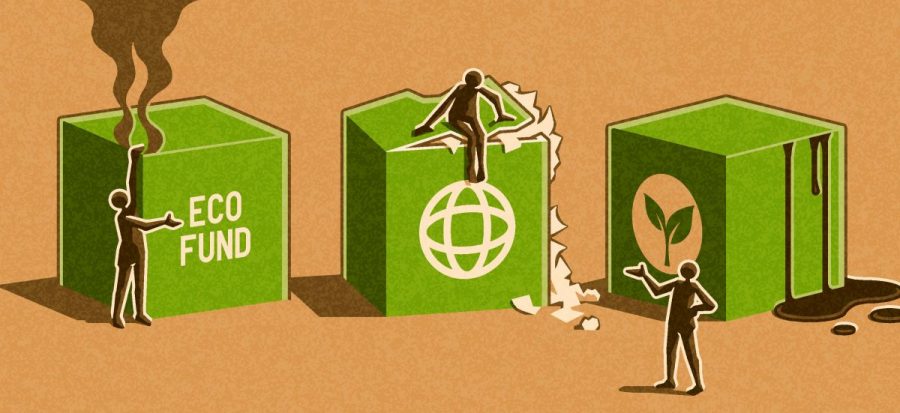Greenwashing: A Marketing Guide to Deceiving Consumers
Photo Credit: Impakter
Misleading consumers through advertisement has become a common practice in a variety of industries attempting to gain extra profit or shield themselves from public scrutiny.
December 15, 2019
For a moment, stop and picture this: A majority of territories in the world became uninhabitable. Polluted air requires people to stay indoors and wear gas masks. The extinction of animals and plants hindered resources for medicine and food, which then gives little wiggle room provided that there is little drinking water and fertile land.
Once booming urban centers have been evacuated due to the rise of disease; Floods, fires, and waste have destroyed the places where once, history was made.
You may have heard of these scenarios of a dystopian world in novels, speeches, and movies. Maybe this is a perspective twenty years from now?
Maybe we have another thousand years before it truly becomes an issue? Who knows? Maybe we create innovative technology to restore the Earth or inhabit another planet. Yet, shouldn’t we still make an effort to avoid being put in that position?
During her speech at the 2019 United Nations Climate Action Summit, 16-year-old environmental activist, Greta Thunberg, declared, “People are suffering. People are dying. Entire ecosystems are collapsing. We are in the beginning of a mass extinction and all you can talk about is money and fairytales of eternal economic growth. How dare you.”
The past two decades have progressively spanned an influx of ecological propaganda in hopes of decelerating the unearthly draining of our planet’s resources. Though sources vary in the extent of human corruption of our environment and the length of time we may have to stop its demise, there is no denying that our actions add up to each other and if not for ourselves, we must create an example for future generations of a safe and habitable Earth.
Humans have been polluting the Earth for so long it has become natural to undermine its impact. However, in the last few years, human pollution has become more noticeable.
Many may have heard of the Great Pacific Garbage Patch, the Deepwater Horizon Oil Spill, or the toxic levels of air pollution in London. This realization leads many to develop a conscience to their impact on the world and an ambition to alleviate the situation in any way they can, including domestic means.
Today, products marketed as eco-friendly and natural are becoming more and more popular among consumers with a noble desire to help the planet. With this information, industries have knowingly began to target an unassuming audience to generate greater profit.
While some brands remain discreet about their methods by simply using simpler design packaging and images of nature in order to trick consumers, some companies go as far as advertising misleading or irrelevant claims, or hiding conditions to their statements in order to generate profit.
Since the 1960s, this marketing technique has become so common that in 1999, it was defined as Greenwashing and added to the Oxford Dictionary. Then, only ten years later, TerraChoice Environmental Marketing published a report in 2009 estimating that over 98% of all green products in the market were deceiving in some way.
Procter & Gamble (P&G), for example, claimed to be “committed to reducing its annual emissions by 50 percent by 2030,” reported Jennifer Skeene, an Environmental Law Fellow, to Newsweek, “these only include Scope 1 and 2 emissions, failing to account for Scope 3 emissions.”
Scope 3 is defined as a category for all indirect greenhouse gas emissions produced by third parties, and in Procter & Gamble’s case, it encompasses 98% of their emissions.
By purposefully marketing the quote without the full context, and often hiding it under hundreds of document pages, companies around the world mislead consumers of their own impact on the environment.
Other examples of greenwashing include the 2018 Starbucks lid without a straw – which in fact had more plastic than the combination of the old lid and straw – and Fiji Water’s advertisement depicting natural landscapes and animals while an innocent-sounding voice says, “bottled at the source, untouched by man.”
The imagery directs the audience to ignore the plastic bottles that are shipped from across the world, and instead view the crystal liquid as a natural and eco-friendly product.
Currently, the top five most greenwashed products are: coal, clothes, bottled water, soft drinks, and gas. While many still have a strong conscience of the effects of coal, gas, and bottled water industries, consumers are often trapped by the claims of clothing and soft drinks brands.
Both remain the second and fourth most greenwashed products, fast fashion often being the most unsuspecting of all.
These examples of the Greenwashing marketing tactic misleads people into paying more, or unconsciously over consuming products, that do not protect the environment as the advertisements state, either directly or indirectly.
Not only are companies restricting consumers of their choice in sustainability, but they are essentially being given a free pass to pollute and exhaust the Earth’s resources.



